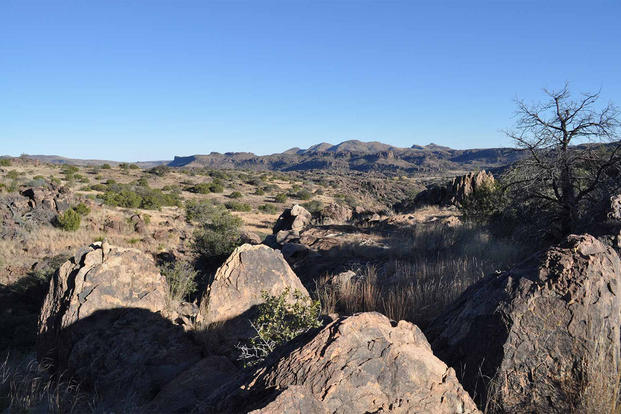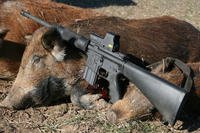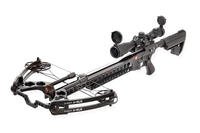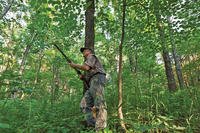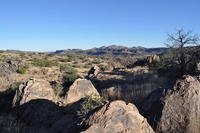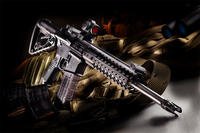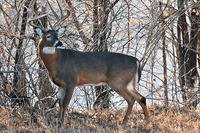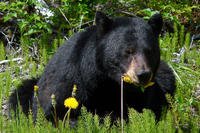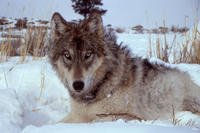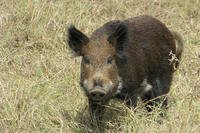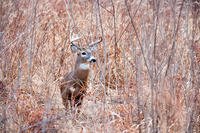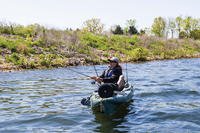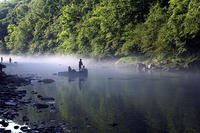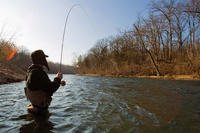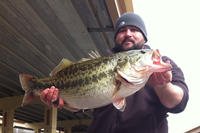Even in winter, temperatures can approach 90 degrees, or it can be icy cold. The fact that you can experience both extremes the same day makes dressing for the weather tricky.
Without the thorn brush, the country would be a rolling prairie—as the first Spanish explorers described the land. It is a vexing problem to find any elevation. The predator calling here is often a short-range, fast-action affair, where the shooter has only a second or two to make his shot. It will make a predator hunter into a fast, accurate shot, or turn him into a frustrated, nervous wreck!
Note to eastern dense-woods hunters—the West isn't all long range, open country! For example, I was calling coyote on a ranch full of the critters, but equally thick with brush. That day, I headed out just as it became light enough to see. I heard coyote from the ranch house the night before and picked an intersection of two ranch roads for my first stand. The roads formed a "T" with the right-hand road going to a windmill. I expected the coyote to come from that direction. I was wrong.
I had been calling for less than three minutes when a coyote burst from the brush on my left. It ran into the road less than 20 yards in front of me, saw me and slid to a stop in a cloud of caliche dust. In a microsecond, it spun around and headed back into the brush. I slapped the rifle to my shoulder, found hair in the scope and slapped the trigger. The 55-grain V-Max hit the coyote in the neck, and it rolled out of sight into the brush, down and dead. From the time I saw the coyote until it lay dead probably took only three seconds. Predator calling in the Texas Brush Country can be very fast!
Brush Country is Shotgun Country
These situations—East or West—call for a 12-gauge shotgun loaded with something like T-shot or buckshot. If I had a partner, one of us would have a shotgun. In really close cover you can have too much scope. The 2-7X works best when you are calling in the brush. A regular 3-9X is also a fair choice, provided you keep it at the low end.
The best shotgun is a 12-gauge chambered for 3-inch shells. The only addition could be a magazine extension, so it holds six rounds. I prefer a modified choke, because it usually patterns buckshot and tungsten loads the best. Improved cylinder doesn't provide enough range. Nothing can match a shotgun for quick work inside 25 yards. Stay away from 00 and stick to the smaller buckshot like B, BB, and #4 that give denser patterns. I shoot a lot of Federal 2 ¾-inch lead BBs or Winchester's 3-inch Xtended Range Hi-Density shotshell load with 1 3/8 ounces of non-toxic size-B shot. Both are deadly on coyote and bobcats out to around 40 yards.
Author's note: Mossberg has a new tactical model pump shotgun on the market, the 835 Ulti-Mag Tactical Turkey, that may just be the answer to the predator caller's prayers. It is camouflaged and has a pistol grip.
Brush Rifles & Rounds
For a brush rifle, I prefer the .25-06. Some may feel it is too powerful, and if you keep pelts, that is probably correct. South Texas fur is rarely worth keeping, and I want the animal dead on the spot. In heavy brush, an animal can be gone in 10 yards. Small caliber varmint rifles shooting frangible bullets do not reliably cause a blood trail. Three hunters and I once looked for a bobcat for nearly an hour in a patch of brush that you could throw a rock across. It was hit poorly with a .223 and left no blood trail. We finally found it, but it took a long time. The .25-06, loaded with 87-grain Sierra Spitzers, 87-grain Speer TNT hollow points, or 85-grain Nosler Ballistic Tips, is another excellent cartridge. Hit a coyote solidly with a .25-06, and it will be there when you go to pick it up.
Another good brush call is the .22-250, a great predator hunting round when loaded with 55-grain bullets like Ballistic Tips, Winchester Power Points, Hornady Spire Points and V-Maxes. Choose a bullet that will give plenty of penetration. I have seen several instances of bullet blow-ups that caused a long search for an animal that the hunter could have killed on the spot with a heavier, sturdier bullet. The .223 WSSM falls into this same category. It is a very fine round for coyote, every bit as good as the .22-250.
The .223 Remington and the .222 Remington are a bit small unless you use stout 55-grain bullets, preferably Nosler Ballistic Tips, for fast anchors in dense brush. I'm sure many will argue the opposite, but my brush philosophy is an instant kill with no travel. Heavier, faster cartridges do that best.
Find A Sendero!
Tactics in the Brush Country are also different. Instead of looking for a ridge that lets you see several hundred yards, as is common practice elsewhere, you have to find large clearings in the brush. Seeing 100 yards is rare, and anything over 50 is a honey hole. Coyote love large prickly pear flats surrounded by thick mesquite. Prickly pear patches are home to large populations of packrats and other prey. I seldom find coyote in truly heavy Texas brush. That terrain, like large whitebrush thickets, is bobcat habitat. Coyote are runners and chasers rather than slinkers and ambushers—like cats—and because of this, they prefer a bit of working room. A great calling location is the intersection of two roads or senderos (Sendero: Spanish for path. A long, narrow cleared strip in the brush). These senderos are common and may run for miles in a straight line. They are made by electrical companies for highline rights of way, by oil companies for exploration and by ranchers for simple access to waterers and service feeders. They are commonly used as roads and as shooting lanes.
If you can find a place that offers a bit of elevation, it's usually a good place from which to call, especially if it allows you to look down into the brush and gets you above the predator. I call from such places when I find them, but they are in short supply in heavy brush. More often that not, I just find a large opening in an area I think harbors coyote, and then place myself on the downwind or crosswind side, depending on the circumstances. If it is a truly large area with good vision all around, a stand in the middle with two hunters looking in different directions—one watching straight downwind—is a good idea, especially if bobcats are a possibility. Bobcats are famous for ignoring scent and coming in straight downwind. In the Brush Country, you will call in a lot more animals than you see, but you sometimes have to give the downwind side to the animals and hope for the best.
Deer Stands Work
I have done a lot of calling from elevated blinds. They are usually well situated, and animals are accustomed to seeing them; they offer great concealment. They are made-to-order for the predator caller—especially with a remote call—and I do use them often with good success.
Sounds of the Brush Country
The brush is full of small birds and mammals. Cactus patches harbor huge numbers of pack rats, kangaroo rats, field mice and other tasty creatures. A call with a higher pitch is better for most circumstances. Small rodent or bird sounds—like the woodpecker—or even a squealing piglet should do the trick.
Close cover hunting is made for decoys. A decoy in front of the caller keeps the predator's attention long enough for a shot. In close range confrontations, movement by the hunter can blow the whole set. A decoy lessens the chances of the predator seeing the hunter by holding its attention elsewhere.
Brush Country can be claustrophobic for those accustomed to calling predators on the prairies. However, if you keep in mind that everything in the brush happens faster and closer, you can have some great, adrenaline-charged, in-your-lap callings. Simply adjust your tactics and tools for this close-range hunting and enjoy the challenge.
